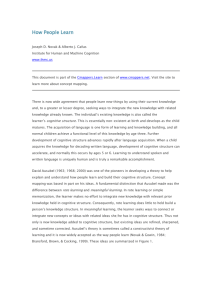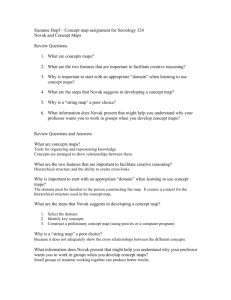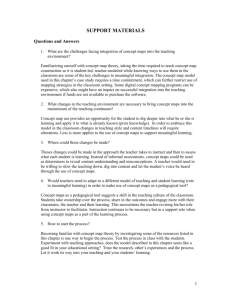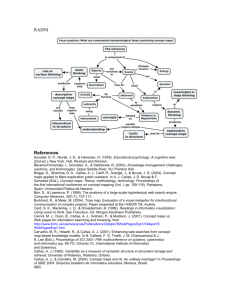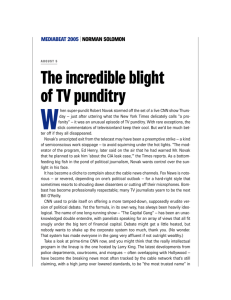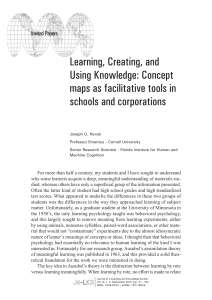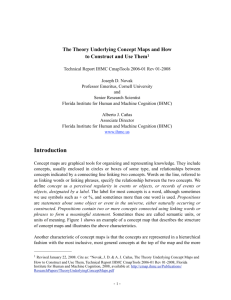The Origins of the Concept Mapping Tool and the Continuing
advertisement
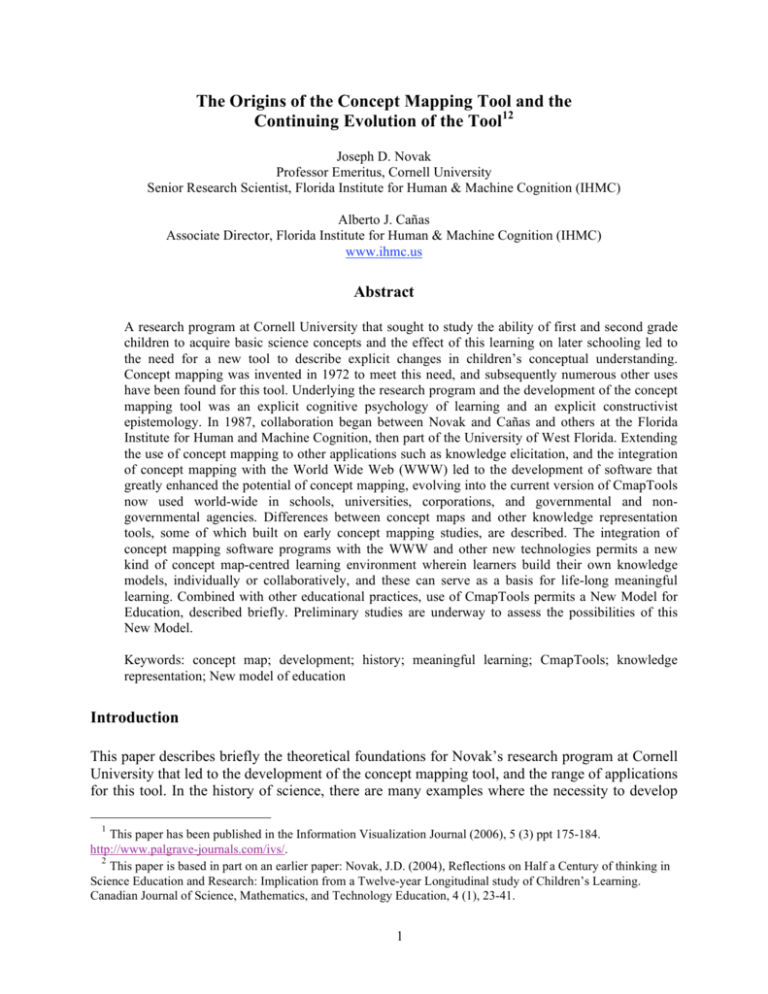
The Origins of the Concept Mapping Tool and the Continuing Evolution of the Tool12 Joseph D. Novak Professor Emeritus, Cornell University Senior Research Scientist, Florida Institute for Human & Machine Cognition (IHMC) Alberto J. Cañas Associate Director, Florida Institute for Human & Machine Cognition (IHMC) www.ihmc.us Abstract A research program at Cornell University that sought to study the ability of first and second grade children to acquire basic science concepts and the effect of this learning on later schooling led to the need for a new tool to describe explicit changes in children’s conceptual understanding. Concept mapping was invented in 1972 to meet this need, and subsequently numerous other uses have been found for this tool. Underlying the research program and the development of the concept mapping tool was an explicit cognitive psychology of learning and an explicit constructivist epistemology. In 1987, collaboration began between Novak and Cañas and others at the Florida Institute for Human and Machine Cognition, then part of the University of West Florida. Extending the use of concept mapping to other applications such as knowledge elicitation, and the integration of concept mapping with the World Wide Web (WWW) led to the development of software that greatly enhanced the potential of concept mapping, evolving into the current version of CmapTools now used world-wide in schools, universities, corporations, and governmental and nongovernmental agencies. Differences between concept maps and other knowledge representation tools, some of which built on early concept mapping studies, are described. The integration of concept mapping software programs with the WWW and other new technologies permits a new kind of concept map-centred learning environment wherein learners build their own knowledge models, individually or collaboratively, and these can serve as a basis for life-long meaningful learning. Combined with other educational practices, use of CmapTools permits a New Model for Education, described briefly. Preliminary studies are underway to assess the possibilities of this New Model. Keywords: concept map; development; history; meaningful learning; CmapTools; knowledge representation; New model of education Introduction This paper describes briefly the theoretical foundations for Novak’s research program at Cornell University that led to the development of the concept mapping tool, and the range of applications for this tool. In the history of science, there are many examples where the necessity to develop 1 This paper has been published in the Information Visualization Journal (2006), 5 (3) ppt 175-184. http://www.palgrave-journals.com/ivs/. 2 This paper is based in part on an earlier paper: Novak, J.D. (2004), Reflections on Half a Century of thinking in Science Education and Research: Implication from a Twelve-year Longitudinal study of Children’s Learning. Canadian Journal of Science, Mathematics, and Technology Education, 4 (1), 23-41. 1 new tools to observe events or objects led to the development of new technologies. For Novak’s research program, the necessity to find a better way to represent children’s conceptual understandings and to be able to observe explicit changes in the concept and propositional structures that construct those understandings led to the development of the tool we call a concept map. This tool has now become a powerful knowledge representation tool useful not only in education but in virtually every sector of human activity. We begin with a brief historical sketch of problems and issues addressed in the research program, and proceed to describe how the integration of concept mapping with new technologies have enabled the development of software programs that greatly enhance the capabilities of the tool. One of the issues debated in the early 1960’s was the extent to which children could profit from instruction on abstract, basic science concepts such as the nature of matter and energy. The dominant thinking in science education and developmental psychology was centered on the work of Jean Piaget [1], particularly his ideas about cognitive operational stages. Piaget had devised some ingenious interviews administered to children, the results of which could be interpreted to support his theory of stages of cognitive operational development. It was widely assumed that children could not profit from instruction in such abstract concepts as the nature of matter and energy before they reached the formal operational stage of thinking at ages 11 or older. The fundamental questions that concerned Novak and his research group were: 1. Are these claimed cognitive operational limitations of children the result of brain development, or are they at least partly an artifact of the kind of schooling and socialization characteristic of Piaget’s subjects, and those commonly tested in US and other schools? 2. With appropriate instruction in basic science concepts such as the nature of matter and energy, can six to eight year-old children develop sufficient understanding to influence later learning? 3. Can the development of children’s understanding of science concepts be observed as specific changes in their concepts and propositions resulting from the early instruction and from later science instruction? 4. Will the findings in a longitudinal study support the fundamental ideas in Ausubel’s [2] assimilation theory of learning? Answers to these questions could only be obtained by first designing systematic instruction in basic science concepts for 6-8 year-old children, and then following the same children’s understanding of these concepts as they progressed through school, including later grades when formal science courses were taken. We were interested in observing very specific changes in the concept and propositional meanings held by the children as they progressed through school, in accordance with Ausubel’s[2] cognitive theory of learning. This was the instructional development and research project Novak’s group set out to do. Development of instructional materials in the longitudinal study was by means of audio-tutorial lessons, in which children learned from audiotapes that were developed and that were supplemented with film clips and equipment. The audio-tutorial lessons were based on ideas in the National Science Teachers Association report, Importance of conceptual schemes for science 2 teaching [3], and an elementary science textbook series, The World of Science [4]. Development of these lessons began in 1965, and a sufficient pool of lessons was available by 1970 for a planned longitudinal study. The study began in 1971 with 191 first grade children (age 6) who received 28 audio-tutorial lessons in grades one and two, and 48 children who did not receive these lessons. Children were interviewed periodically throughout their school tenure, grades one through twelve, to ascertain the extent to which they were acquiring an understanding of concepts of matter, energy, and living systems. The key principle of the Ausubelian learning theory [2, 5] we considered in the design of our lessons comes from the epigraph to his 1968 book: If I had to reduce all of educational psychology to just one principle, I would say this: The most important single factor influencing learning is what the learner already knows. Ascertain this and teach him accordingly. Together with the graduate students we would develop an idea for a new lesson, interview 6-8 primary grade children in an open ended interview, usually using some of the “props” we were planning to use to teach the central concepts of the lesson, such as pictures, materials to be manipulated, loop films or apparatus we were considering. These interviews gave us some idea of what anchoring concepts most of the children already had, and gave some preliminary feedback on how they were interpreting or using the props. This process was often repeated several times, and again after lesson prototypes were developed. On average, each lesson underwent 6-8 revisions before it was deemed ready to use in classrooms. We also considered Ausubel’s ideas of progressive differentiation and integrative reconciliation in designing the lessons and lesson sequences. The idea of progressive differentiation requires that students build upon their prior relevant concepts, and elaborate concepts acquired in earlier audio-tutorial lessons in a sequence as they study later related lessons. Furthermore, many concepts were revisited in later lessons, but with different examples or props to effect greater differentiation of concepts introduced earlier, and thus also to achieve integrative reconciliation of concepts. The principle of integrative reconciliation applies to the clarification of ideas that may have been initially confusing to a child or where meanings acquired may have been somewhat distorted. Learners often hold misconceptions or faulty ideas that need to be modified or remediated, a process that requires meaningful learning [6]. We used things that were familiar to the students, and we would build on the familiar to point them to see new aspects or dimensions of the new materials observed, much of this through the audio guidance. We designed interviews to use some of the materials that were in the lessons and other materials that were different but illustrated the same concepts. We prepared interview kits, and these were used by a number of different graduate students, with some instruction in how to do the interviews. Interviews were done with the Instructed students several times during the first year, including interviews on topics other than the nature of matter and energy. However, we found we did not have the staff resources to continue interviewing all Instructed and Uninstructed students on several domains of science, and chose to interview students only on concepts of matter, energy, and energy transformations. The same interview kits were used as the students progressed through school, and over the 12 years of the study. We also did not have staff to interview all students each year, and we had to choose a random sample from the Instructed and 3 Uninstructed groups for later years of the study. All interviews were tape-recorded and some were video-recorded. During the course of the study, 24 different graduate students and staff members participated in the interviewing and later analysis of the data. The Invention of Concept Mapping As our longitudinal study progressed, we were accumulating hundreds of interview tapes. As we transcribed the tapes, we could observe that propositions used by students would usually improve in relevance, number, and quality, but it was still difficult to observe specifically how their cognitive structures were changing. Our research team considered various alternatives we might explore, and we again reviewed Ausubel’s ideas regarding cognitive development. Three ideas from Ausubel’s Assimilation Theory emerged as central to our thinking. First, Ausubel sees the development of new meanings as building on prior relevant concepts and propositions. Second, he sees cognitive structure as organized hierarchically, with more general, more inclusive concepts occupying higher levels in the hierarchy and more specific, less inclusive concepts subsumed under the more general concepts. Third, when meaningful learning occurs, relationships between concepts become more explicit, more precise, and better integrated with other concepts and propositions. In our discussions, the idea developed to translate interview transcripts into a hierarchical structure of concepts and relationships between concepts, i.e., propositions. The ideas developed into the invention of a tool in 1972 we now call the concept map. Concept maps, as we use the term, show the specific label (usually a word or two) for one concept in a node or box, with lines showing linking words that create a meaningful statement or proposition. We define concepts as perceived regularities or patterns in events or objects, or records of events or objects, designated by a label. Concepts are arranged hierarchically with the most general, most inclusive concept at the top, and the most specific, least general concepts toward the bottom. Propositions are statements about some event or object that shows a relationship between two or more concepts. There may also be cross-links showing relationships between concepts in two different areas of the concept map. Identifying new crosslinks may sometimes lead to a creative insight. Concept maps are also based on an explicit cognitive psychology of learning, and constructivist epistemology, as noted below. Other knowledge representation schemes, such as Mind Maps [7], usually lack one or more of the above characteristics. Many software programs such as Inspiration, Smart Ideas, and others built on communications with Novak or on his writings. Other forms of knowledge representations have been described by Jonassen, Beissner, & Yacci [8], as well as others. Information Visualization publishes papers describing a much broader range of information visualizations techniques, some of which are very different from concept maps that deal primarily with concept and propositional knowledge (see Novak & Cañas [9] for further information on the Theory Underlying Concept Maps and their use). We were somewhat surprised to find that we could rather easily transform the information in an interview transcript into a concept map. We found that a 15-20-page interview transcript could be converted into a one-page concept map without losing essential concept and propositional meanings expressed by the interviewee. We soon realized this was a very powerful and concise knowledge representation tool, a tool that changed our research program from this point on. 4 Figure 1 shows examples of concept maps we drew from interview transcripts for one average Instructed student at the end of grades 2 and 12. Note that while new concepts such as “atom” are assimilated into her cognitive structure, she also has acquired some new misconceptions. This is characteristic of students who sometimes learn by rote and sometimes at relatively low levels of meaningful learning. Figure 2 shows concept maps we drew from interview transcripts with one Uninstructed student at the end of grades 2 and 12. This latter student was obviously disposed to learn meaningfully rather than by rote, and he shows clear evidence of progressive differentiation and integrative reconciliation of his cognitive structure in this domain of knowledge. However, the mean quality of maps for Instructed students was substantially better than for Uninstructed students [10]. A B Figure 1. Two concept maps drawn from interviews with an average-ability audio-tutorial instructed student at the end of grade 2 (A above) and at the end of grade 12 (B above). Notice that while she has more knowledge, she also shows some misconceptions. 5 A B Figure 2: Two concept maps constructed from interviews with an exceptionally good student, who did not receive audio-tutorial instruction, at the end of grades 2 (A above) and at the end of grade12 (B above). Note the high degree of acquisition and integration of new concepts and propositions. For our research project, the use of concept maps drawn from structured interviews became the primary tools we used to ascertain what learners know at any point in their educational experience. While it does take an hour or two for an experienced person to make a concept map from a 20-30 minute interview transcript, the precision and clarity of the learner’s cognitive structure represented this way made it relatively easy to follow specific changes in the student’s knowledge structures as she/he progressed through the grades. We also used concept maps made by our research staff to identify valid and invalid notions held by students. It should be noted that these concept maps were made by many different graduate students over the span of the study, but still the consistency in the patterns observed for each student was remarkable. This illustrates 6 in part the robustness and validity of this form of knowledge representation, as well as consistency in interviewer elicitations over time. The consistency with which the same valid or faulty knowledge structures were shown in concept maps drawn by different researchers illustrates the robustness and reliability of the technique of representing children’s understandings in the form of concept maps. Subsequently other investigators have also found concept maps to be reliable, valid indicators of conceptual understanding and changes in relevant concept and propositional structures over time [11-13]. Development of a New Epistemology The 1960s and 1970s was also a time when a new epistemology was emerging, catalyzed by such works as Kuhn’s [14] The Structure of Scientific Revolutions and Toulmin’s [15] Human Understanding: the Collective Use and Evolution of Concepts. This emerging realist or constructivist epistemology viewed the creation of new knowledge as a social, human endeavor, fraught with human successes and failures and constantly evolving. This contrasted with the “immutable truths” or “laws” that the positivists sought to derive from empirical studies “unfettered” by preconceived notions [16, Ch. 2]. Ausubel’s assimilation theory could well serve as a foundation for constructivist epistemology, since it explained an individual’s development of conceptual understanding in a way closely paralleling creation of knowledge in the sciences or any other discipline. Toulmin’s description of the evolving nature of disciplinary concepts, with new ideas building upon and modifying existing concepts, could be seen as paralleling how an individual’s conceptual understandings develop, as described by Ausubel [17]. Today most members of the education community embrace a constructivist epistemology, but this was certainly not the case during the early years of our longitudinal study. From our research with children and adults, it became increasingly apparent to us that meaningful learning was the most important factor in building powerful knowledge structures, and by contrast, learning by rote contributed little to building individual’s knowledge structures, nor does rote learning result in the remediation of misconceptions held by learners. Novak found that the use of concept maps could help students learn how to learn meaningfully, and taught a course at Cornell University for 20 years to help students become better learners. This course led to the book, Learning How to Learn [18] now published in 9 languages. In the 1980’s, Novak’s research program focused on how to use concept maps to help researchers create new knowledge. In the 1990’s, Novak worked with R&D staff at Procter and Gamble and found that concept mapping not only facilitated better organization of research team’s knowledge, but also facilitated creative work by the team. These works are summarized in Learning, Creating, and Using Knowledge: Concept maps as Facilitative Tools in Schools and Corporations [19]. In all of this work the most fundamental idea is that meaningful learning not only helps learners acquire more powerful knowledge structures, but it is also the means for the creation of new knowledge. This idea is illustrated in Figure 3. 7 Figure 3. A key idea in Ausubel’s learning theory is that new learning can vary from very rote to highly meaningful. Creativity is seen as a very high level of meaningful learning. Development of Computer-based Concept Mapping Tools For many years, concept map were drawn by hand. Iterating through revisions of a concept map was cumbersome and time consuming. Group concept mapping sessions could be handled by using post-it notes. The introduction of personal computers enabled the development of software programs that facilitated the construction of concept maps. Initial versions of concept mapping programs, however, did not enhance the power of the tool – they were limited to displaying a concept map on the screen. Programs like Inspiration popularized the use of concept mapping in elementary school education by allowing children to easily add pictures and clipart to concepts. Other software program like Knowledge Manager and Smart Ideas have also taken advantage of technology to facilitate the construction of concept maps. However, it was the marriage of the concept map and the Internet that launched a completely new world of applications and uses for concept mapping, as exemplified by the CmapTools [20] software. In 1987, Novak was invited to spend a sabbatical leave at the University of West Florida by Bruce Dunn, a former Cornell PhD student. This began an association with the Florida Institute for Human and Machine Cognition (IHMC, http://www.ihmc.us), then part of the University of West Florida, that continues today. Among the research activities at IHMC was the development of software that enhanced the power and applicability of concept maps. By the late 1980’s and beginning of the 1990’s concept mapping was being used at IHMC as a tool for knowledge elicitation [21, 22] and as the explanation component of expert systems [23]. We started using concept maps to organize and navigate through large amounts of information via hyperlinks before the World Wide Web was developed [24]; and using IBM’s internal network, students from schools in many Latin American countries were able to collaborate in the construction of 8 concept maps before Internet was available in their countries [25-27]. These efforts led to the development of CmapTools [20], a client-server software tool to facilitate the construction and sharing of concept maps. CmapTools (the latest version of the software can be downloaded at no cost for non-profit use at: http://cmap.ihmc.us) exemplifies how, by leveraging the Internet and the WWW, the concept map goes beyond a knowledge representation tool, becoming also a mechanism to structure and navigate through large amounts of information by serving both as an organization medium as a well as the launching pad for searching and mining the WWW and visualizing information [28-33]. The success of the digital concept mapping approach results from this potential to visualize in a synergistic manner both structures of knowledge and information. It, thus, may compensate for shortcomings inherent in both the knowledge and information visualization approaches [34]. We took advantage of these capabilities in one of our earlier projects with NASA, who sought to make more accessible to the public the large quantity of materials on Mars exploration [35]. Figure 4 shows an example of a couple of concept maps in the collection prepared by Geoff Briggs (http://www.cmex.arc.nasa.gov). Notice that these concept maps show icons under some of the concepts. When the viewer clicks on these attached icons, a list of resources related to that concept is displayed for the user to select. These attached resources can be located anywhere on the Internet and can include other concept maps. This effort demonstrates how concept mapping has evolved by profiting from technological innovations from the field of information visualization, and how an expert’s knowledge can provide an effective knowledge-based structure of information [36]. Kumar and Shangai [37] and Shen et al.[38] report on other attempts to use concept maps as a means to visualize digital libraries. From the effort in the early 1990’s to provide a platform for collaboration at the “knowledge level” (i.e., by sharing propositions) during the construction of concept maps by students from many countries [26], the integration of concept mapping with Internet has resulted in the development of a framework for collaborative work and learning. As an example, the CmapTools Network [39] consists of hundreds of thousands of users accessing hundreds of servers (CmapServers), through which users of all ages and disciplines can share concept maps and collaborate synchronously, or asynchronously via discussion threads, annotations or Knowledge Soups (see http://pictor.ihmc.us/gl for a live world map of CmapTools clients and servers, http://cmapdp.ihmc.us to navigate through the network of CmapServers). The integration of new technology with concept mapping has triggered other applications and extensions to the tool, and we expect this to trend to continue. We site a couple of examples, without any attempt to be comprehensive. The artificial intelligence (AI) community has traditionally seen concept mapping as “not formal enough” as a knowledge representation scheme, and often proposes more formal representations or uses of concept maps. One such effort, COE [40], uses concept map-like representations for capturing and formally representing expert knowledge in the form of ontologies for use in the Semantic Web (COE can be downloaded at http://cmap.ihmc.us/coe). Cañas and Carvalho [41] on the other hand, propose that AI techniques can be used to aid the user in the construction of concept maps without the need to formalize the representation. LEO [42, 43] extends concept mapping to serve as a platform for course information visualization for students and instructors. The Proceedings of 9 CMC2004, the First International Conference on Concept Mapping [44] contains a substantial collection of innovative uses of concept maps. A New Model for Education The development of digital concept mapping software such as CmapTools, when used with the WWW, makes possible what we call A New Model for Education. The idea is that we can build on 30 years of research that shows that we can “coach” or “scaffold” learning of any subject matter in positive ways as long as we carefully consider that meaningful learning is a process in which the learner must be actively engaged [45]. The New Model also builds on Vygotsky’s [46, 1928 in Russian] idea of the “zone of proximal development” (ZPD). Vygotsky’s studies indicated that there is a level of understanding that an individual has in any subject domain from which the learner can advance to a higher level of understanding with minimal coaching or guidance. He anticipated Ausubel’s idea that meaningful learning must begin with what the learner already knows, and then build on this knowledge. One of the values of concept maps is that when learners construct their own concept maps for a question or problem in any domain, they reveal with considerable specificity what is their developmental potential for the topic of study. Thus, we are provided with a clear view of “what the learner already knows” and we can design instruction to build upon this. It is also possible to provide the learner with an “expert skeleton” concept map that builds on what the learner knows and guides the learner in advancing to a higher ZPD. Figure 5 shows an example of an “expert skeleton” concept map we are Figure 4. One of the concept maps prepared by NASA to present information on Mars exploration. Clicking on icons brings up digitized materials, as illustrated in the inserts. 10 Figure 5. An “expert skeleton” concept map provided to guide 4th grade students in their study of science. Individual learners or small groups can work with these skeleton maps and add additional concepts and propositions, some suggested on the left. providing to 4th grade students in our current work in Italy and Panama. Other “expert skeleton” concept maps can be seen at the IHMC Public Cmaps CmapServer under “The World of Science” folder. We generally recommend that learners build concept maps in small groups, since the exchange that occurs between learners can often serve to correct faulty ideas and promote meaningful learning. In part, this results from the fact that the cooperating learners are at approximately the same ZPD level of understanding, much more so than teacher and learner. Thus their exchanges tend to be more meaningful to each member of the group. Cooperative learning also confers an affective advantage to learners over the usual independent, competitive teaching approaches that can be emotionally deleterious [47]. Effective education programs provide for a wide range of learning activities including selected readings, Internet searches, project work, report preparation and presentation, drawings, video presentations, collaborative research, and other activities. With CmapTools, it is possible to develop a general concept map to serve as a framework for guiding these studies and as a tool to integrate all other learning activities into one highly organized knowledge model. This is illustrated in Figure 6. These knowledge models can be shared with others, stored on a server, and used as an “archive” that can serve as a starting point for future studies. CmapTools can be very useful for home study and distance learning [48, 49]. It is exciting to imagine what learning possibilities would accrue if school children began developing their knowledge models for various subject matter domains in early grades and continued this process through secondary and tertiary schools. So far, our work in Italy and Panama is showing progress even though we are 11 only in the early stages of applying the New Model and CmapTools in the projects’ schools. Other efforts are applying the same ideas in the corporate environment, transforming training programs into highly effective educating programs. The result would be higher levels of competence in routine tasks, and higher levels of creativity and success in finding new solutions to problems. Conclusions The extensive and ever growing use of concept mapping throughout the world is reflected in the popularity of digital concept mapping software, its application in all domains of knowledge and by people of all ages, and in the success of the International Concept Mapping Conference (see http://cmc.ihmc.us for information on the conference). The integration of concept mapping with the WWW has opened a whole avenue for research and development where information and knowledge leverage on each other as new means for visualization, and we are only seeing the initial stages of what is possible. Over the three decades that we have been working with concept mapping, we have found virtually every year new methods for creating concept maps and new applications for their use. New technologies have helped increase the number of applications and the power of the tool. It is likely that this evolutionary process will continue in the future, and we look forward to sharing new applications and experiences with others. Figure 6. A representation showing how a concept map for Mars can be used “scaffold” learning in a New Model for Education by adding resources of a wide variety of types. The product becomes an evolving knowledge model that can be saved and improved in the future. 12 References 1. 2. 3. 4. 5. 6. 7. 8. 9. 10. 11. 12. 13. 14. 15. 16. 17. 18. 19. 20. Novak JD. Psychological and Epistemological Alternatives to Piagetian Development Psychology with Support from Empirical Studies in Science Education, In: Modgil S and Modgil C (Eds). Jean Piaget - Consensus and Controversy. Praeger: New York. 1982. 331-349. Ausubel DP, The Psychology of Meaningful Verbal Learning. Grune and Stratton: New York, 1963. Novak JD. The Importance of Conceptual Schemes for Teaching Science. The Science Teacher 1964; 31(6): 10-13. Novak JD, Meister M, Knox WW, and Sullivan DW, The World of Science Series, Books One through Six. Bobbs-Merrill: Indianapolis, IN, 1966. Ausubel DP, Educational Psychology: A Cognitive View. Holt, Rinehart and Winston: New York, 1968. Novak JD. Meaningful Learning: the Essential Factor for Conceptual Change in Limited or Appropriate Propositional Hierarchies (LIPHs) Leading to Empowerment of Learners. Science Education 2002; 86(4): 548-571. Buzan T, Using Both Sides of Your Brain. E. P. Dutton: New York, 1974. Jonassen DH, Beissner K, and Yacci M, Structural knowledge: Techniques for representing, conveying and acquiring structural knowledge. Erlbaum: Hillsdale, NJ, 1993. Novak JD and Cañas AJ, The Theory Underlying Concept Maps and How to Construct Them. 2006, Florida Institute for Human and Machine Cognition: Pensacola, FL. Novak JD and Musonda D. A Twelve-Year Longitudinal Study of Science Concept Learning. American Educational Research Journal 1991; 28(1): 117-153. Shavelson RJ and Ruiz-Primo MA. On the Psychometrics of Assessing Science Understanding, In: Mintzes J, Wandersee J, and Novak J (Eds). Assessing Science Understanding. Academic Press: San Diego. 2000. 304-341. Ruiz-Primo MA and Shavelson RJ. Problems and issues in the use of concept maps in science assessment. Journal of Research in Science Teaching 1996; 33(6): 569-600. Kankkunen M. Concept Mapping and Peirce's Semiotic Paradigm Meeting in the Elementary Classroom Environment. Learning Environment Research 2001; 4: 287-324. Kuhn TS, The Structure of Scientific Revolutions. Univ. of Chicago Press: Chicago, 1962. Toulmin S, Human Understanding. Volume 1: The Collective Use and Evolution of Concepts. Princeton University Press: Princeton, NJ, 1972. Novak JD, A Theory of Education. Cornell University Press: Ithaca, NY, 1977. Novak JD. Human Constructivism: A Unification of Psychological and Epistemological Phenomena in Meaning Making. International Journal of Personal Construct Psychology 1993; 6: 167-193. Novak JD and Gowin DB, Learning How to Learn. Cambridge University Press: New York, NY, 1984. Novak JD, Learning, Creating, and Using Knowledge: Concept Maps as Facilitative Tools in Schools and Corporations. Lawrence Erlbaum Associates: Mahwah, NJ, 1998. Cañas AJ, Hill G, Carff R, Suri N, Lott J, Eskridge T, Gómez G, Arroyo M, and Carvajal R. CmapTools: A Knowledge Modeling and Sharing Environment, In: Cañas AJ, Novak JD, and González FM (Eds). Concept Maps: Theory, Methodology, Technology. 13 21. 22. 23. 24. 25. 26. 27. 28. 29. 30. 31. 32. 33. Proceedings of the First International Conference on Concept Mapping. Universidad Pública de Navarra: Pamplona, Spain. 2004. 125-133. Ford KM, Cañas AJ, Coffey JW, Andrews EJ, and Schad N. Interpreting Functional Images with NUCES: Nuclear Cardiology Expert System. Fifth Florida Artificial Intelligence Research Symposium (FLAIRS) 1992 (Ft. Lauderdale, USA), Florida AI Research Society; 85-90. Ford KM, Cañas AJ, Jones J, Stahl H, Novak JD, and Adams-Webber J. ICONKAT: An integrated constructivist knowledge acquisition tool. Knowledge Acquisition 1991; 3: 215-236. Ford KM, Cañas AJ, and Coffey JW. Participatory Explanation, In: Dankel DD and Stewman J (Eds). Proceedings of the Sixth Florida Artificial Intelligence Research Symposium. FLAIRS: Ft. Lauderadale, FL. 1993. 111-115. Cañas AJ, Ford KM, and Coffey JW. Concept Maps as a Hypermedia Navigational Tool. Seventh Florida Artificial Intelligence Research Symposium (FLAIRS) 1994 (Pensacola, FL). Cañas AJ, Ford KM, Hill G, Brennan J, Carff R, Suri N, and Coffey J. Quorum: Children Collaborating throughout Latin America. Sixth IFIP World Conference on Computers in Education 1995 (Birmingham, UK), Aston University, Birmingham, England. Cañas AJ, Ford KM, Brennan J, Reichherzer T, and Hayes P. Knowledge Construction and Sharing in Quorum. Seventh World Conference on Artificial Intelligence in Education 1995 (Washington DC), Association for the Advancement of Computing in Education; 218-225. Cañas AJ, Ford KM, Novak JD, Hayes P, Reichherzer T, and Suri N. Online Concept Maps: Enhancing Collaborative Learning by Using Technology with Concept Maps. The Science Teacher 2001; 68(4): 49-51. Cañas AJ, Carff R, Hill G, Carvalho M, Arguedas M, Eskridge T, Lott J, and Carvajal R. Concept Maps: Integrating Knowledge and Information Visualization, In: Tergan S-O and Keller T (Eds). Knowledge and Information Visualization: Searching for Synergies. Springer Lecture Notes in Computer Science: Heidelberg/NY. 2005. 205-219. Tergan S-O. Digital Concept Maps for Managing Knowledge and Information, In: Tergan S-O and Keller T (Eds). Knowledge and Information Visualization: Searching for Synergies. Springer Lecture Notes in Computer Science: Heidelberg/NY. 2005. 185-204. Lee YJ. Concept Mapping your Web Searches: a Design Rationale and Web-enabled Application. Journal of Computer Assisted Learning 2004; 20(2): 103-121. Leake DB, Maguitman A, Reichherzer T, Cañas AJ, Carvalho M, Arguedas M, and Eskridge T. Googling from a Concept Map: Towards Automatic Concept-Map-Based Query Formation, In: Cañas AJ, Novak JD, and González FM (Eds). Concept Maps: Theory, Methodology, Technology. Proceedings of the First International Conference on Concept Mapping. Universidad Pública de Navarra: Pamplona, Spain. 2004. 409-416. Cañas AJ, Carvalho M, Arguedas M, Leake DB, Maguitman A, and Reichherzer T. Mining the Web to Suggest Concepts during Concept Map Construction, In: Cañas AJ, Novak JD, and González FM (Eds). Concept Maps: Theory, Methodology, Technology. Proceedings of the 1st International Conference on Concept Mapping. . Universidad Pública de Navarra: Pamplona, Spain. 2004. 135-142. Carvalho MR, Hewett R, and Cañas AJ. Enhancing Web Searches from Concept Mapbased Knowledge Models, In: Callaos N, et al. (Eds). Proceedings of SCI 2001: Fifth 14 34. 35. 36. 37. 38. 39. 40. 41. 42. 43. 44. 45. 46. 47. 48. 49. Multiconference on Systems, Cybernetics and Informatics. International Institute of Informatics and Systemics: Orlando, FL. 2001. 69-73. Tergan S-O. The Use of Digital Concept Maps as a Cognitive Tools for Managing Knowledge and Knowledge Resources. AAAI Technical Report SS-05-06. Papers from the AAAI Symposium "Reasoning with Mental and External Diagrams: Computational Modelling and Spatial Assistance" 2005; 73-76. Briggs G, Shamma DA, Cañas AJ, Carff R, Scargle J, and Novak JD. Concept Maps Applied to Mars Exploration Public Outreach, In: Cañas AJ, Novak JD, and González F (Eds). Concept Maps: Theory, Methodology, Technology. Proceedings of the First International Conference on Concept Mapping. Universidad Pública de Navarra: Pamplona, Spain. 2004. 109-116. Keller T and Tergan S-O. Visualizing Knowledge and Information: An Introduction, In: Tergan S-O and Keller T (Eds). Knowledge and Information Visualization: Searching for Synergies. Springer-Verlag: Heidelberg. 2005. 1-23. Kumar A and Saigal R. Visual Understanding Environment. Proceedings of the 5th ACM/IEEE-CS Joint Conference on Digital Libraries 2005 (Denver, Colorado), ACM Press; 413-413. Shen R, Richardson R, and Fox EA. Concept Maps as Visual Interfaces to Digital Libraries: Summarization, Collaboration, and Automatic Generation. Online available March 2006: http://vw.indiana.edu/ivira03/shen-et-al.pdf Cañas AJ, Hill G, Granados A, Pérez C, and Pérez JD, The Network Architecture of CmapTools. 2003, Institute for Human and Machine Cognition: Pensacola, FL. Hayes P, Eskridge TC, Saavedra R, Reichherzer T, Mehrotra M, and Bobrovnikoff D. Collaborative Knowledge Capture in Ontologies. K-CAP'05 2005 (Banff, Canada), ACM. Cañas AJ and Carvalho M. Concept Maps and AI: an Unlikely Marriage? Proceedings of SBIE 2004: Simpósio Brasileiro de Informática Educativa. SBC: Manaus, Brasil. 2004. Coffey JW and Cañas AJ. LEO: A Learning Environment Organizer to Support Computer-Mediated Instruction. Journal for Educational Technology 2003; 31(3): 275290. Coffey JW. LEO: A Concept Map-based Course Visualization Tool for Instructors and Students, In: Tergan S-O and Keller T (Eds). Knowledge and Information Visualization: Searching for Synergies. Springer-Verlag: Heidelberg. 2005. 270-286. Cañas AJ, Novak JD, and González F, Concept Maps: Theory, Methodology, Technology. Universidad Pública de Navarra: Pamplona, Spain, 2004. Bransford J, Brown AL, and Cocking RR, eds. How People Learn: Brain, Mind, Experience, and School. National Academy Press: Washington, D.C., 1999; xxiii, 319pp. Vygotsky L, Mind in Society: the Development of Higher Psychological Processes, ed. Cole M and Scribner C. Harvard University Press: Cambridge, MA, 1978. Qin Z, Johnson DW, and Johnson RT. Cooperative versus Competitive Efforts and Problem Solving. Review of Educational Research 1995; 65(Summer): 129-143. Novak JD. Using Concept Maps to Facilitate Classroom and Distance Learning. Scuola & Citta 2002; 2: 112-114. Cañas AJ. Algunas Ideas sobre la Educación y las Herramientas Computacionales Necesarias para Apoyar su Implementación. Revista RED: Educación y Formación Profesional a Distancia, Ministry of Education, Spain 1999. 15
